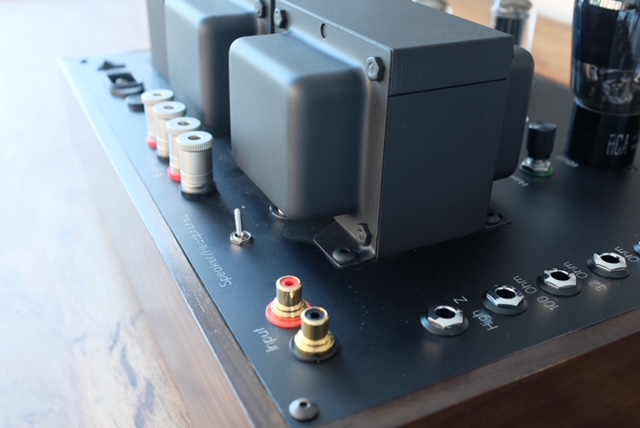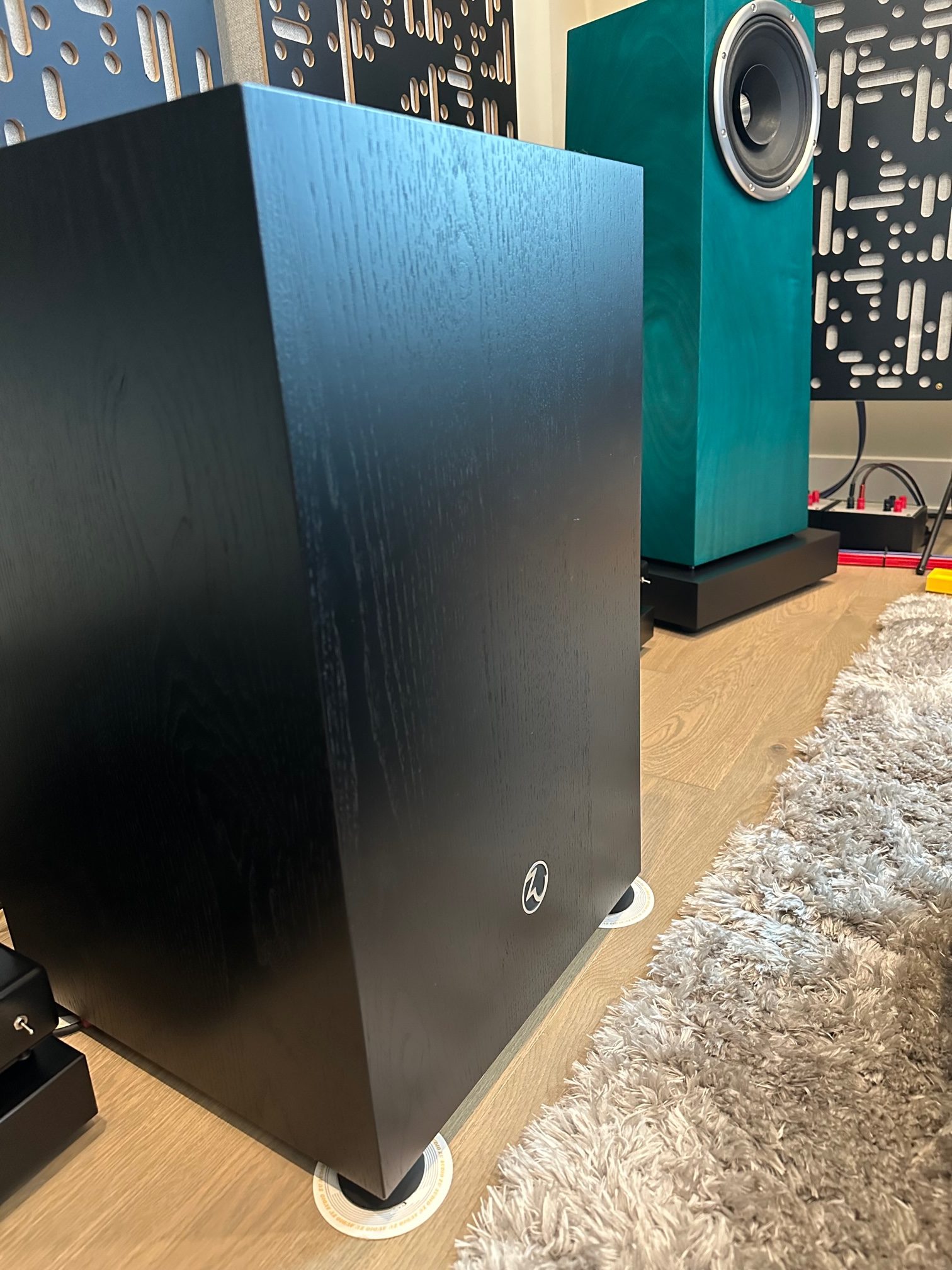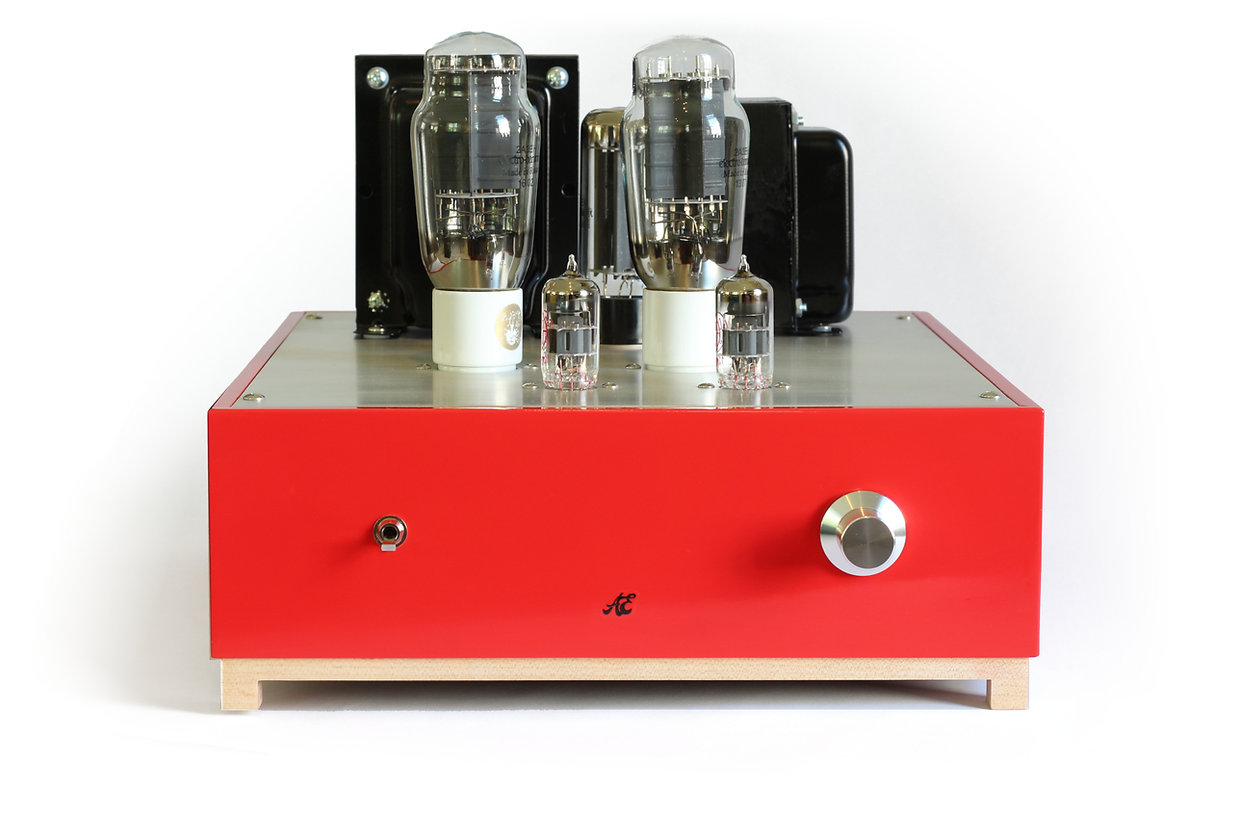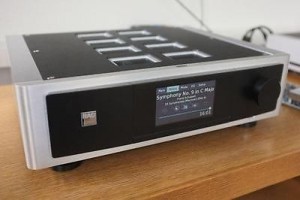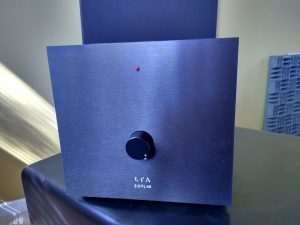For the last five weeks, I have had the opportunity to sit back and enjoy one of the best amplifiers I have heard in a long time. It all started when I got a phone call from the owner of ampsandsound, he said he had something new and special in the works. I was intrigued, he then told me it was a direct heated triode, and that it was powerful enough to drive speakers and my SUSVARA headphones. He then said he was sending me a review unit in three weeks. The Rockwell arrived three weeks later, and I can happily say it will not be leaving.
Looking Closer at the Rockwell
The Rockwell is a single ended amplifier with zero feedback, and it employs direct heated triodes for its power tubes. Like the ampsandsound Bigger Ben, it uses a 6SL7 input tube, and it is tube rectified. The out transformers are massive and over spec'd and provide five output impedances (8, 16, 32, 100, and 300). This allows you to match this amp to pretty much any headphone. Like the Bigger Ben, it has Jupiter capacitors, and input transformers, and one single ended input. Volume control is a very high quality stepped attenuator, and it has speaker binding posts on the back of it, making it an integrated amplifier.
As has been my experience with every ampsandsound product that I have held, the Rockwell has a jewel-like finish. In my opinion, the walnut case of my Rockwell is the best casework I have seen out of ampsandsound. It is just the right tone, is slightly darker and a little more grey then the other walnut cases I have gotten in the past. This is not a light amplifier, and caution should be used when lifting it, as it is much denser then it appears. Like Justin Weber's (the owner of ampsandsound) other amplifiers this amp shipped in a comically large Seahorse Case.
Let's talk about tubes
Direct heated triodes (DHTs) have a cult-like following. Some of the best and most legendary audio tubes were direct heated triodes, for example the 300B and the 2a3. DHTs, in particular, the 2a3 and 300B, are known for tonal accuracy, and mid-range performance that make speakers disappear. The problem is that getting the new old stock (NOS) tubes to maximize the performance of the amp is a small fortune or impossible.
This is where the 6B4G comes in, while not overly common, it is possible to purchase a nice pair of these for under $200. I know this because I bought 4 pairs, all brand new, in box. All 1930s and 1940s vintage, and I spent less than $500 in total. Here's the kicker though, a 6B4G is equivalent to a 6a3 (Octal vs 4 Pin base), and a 6a3 is the same as a 2a3 but with a different heater current. Yes that's right, you get to run a tube that is more or less identical to a 2a3 that can be bought NOS for under $200 a pair.
When asking Weber why he chose this output tube, he explained the above to me and said "the Rockwell is a smart man's DHT." I have to agree with him. Performance per dollar, this is simply a winning formula.
The same is true for the rectifier, Weber chose to use a 6AX5GT as the rectifier tube for this amp. He chose this partially for its ease of acquisition (NOS black plates can be had for under $20 a tube) but also because it was a 6 volt rectifier (as opposed to the 5AR4 or 5U4 which are five volt rectifiers). This is important because that would mean that the entire amp would run at six volts, and with that he was able to design a simpler power supply, with it a quieter amplifier. While the Rockwell uses the same size power transformer as a Bigger Ben, it uses a choke that is half the size that allows it to be a bit more dynamic. This is surprisingly noticeable when shifting back and forth between the ampsandsound Nautilus and Rockwell. We will talk about that more later.
Coming back to the power tubes, direct heated triodes (DHTs) do have one negative, and that is noise. They are naturally more noisy than indirectly heated tubes and Justin really wanted to ensure that the Rockwell is quiet enough to run more sensitive headphones on. To achieve this he added hum pots to the Rockwell. If you look behind the power tubes, you will see dials, one for each power tube. The Rockwell uses AC for its filaments and the hum pots allows you to make adjustments to ensure the 60hz hum is cancelled. The hum pots proved their worth early on, with my 4 pairs of 6B4Gs, each pair required a slight adjustment to the hum pot and after adjustment. Then it was silent on both my speakers and my SUSVARA headphones.
Weber also uses the 6SL7 tube, which is one of my all-time favorite tubes. I currently own around 40 of them, and I am consistently drawn to them because of their musicality, their big plates, and the ability to get incredible sounding NOS tubes for under $50 a tube.
So in summary, the Rockwell is similar to Weber's other amplifier, the Kenzie, in that it is an amplifier that you can re-tube with entirely NOS tubes for under $300. This is simply awesome, and if you buy a Rockwell, it is worth your time and money to find NOS tubes for it.
Initial Setup
The Rockwell was wired into my system using WyWires Platinum single ended interconnects. For digitally sourced music, I used my NUC based Roon Core, streaming to my AURALiC Aries G1, connected with a Final Touch Audio Callisto USB Cable to my Chord DAVE and a Chord Hugo M Scaler. When listening to my digital sources, the DAVE provided volume control with the Rockwell's volume control set to 100% (bypass).
For my Analog setup, I used a VPI Classic Signature with a AT-OC9XSL moving coil cartridge, with phono pre-amp duty being handled with the Whest audio 40RDT. Like above, all analog interconnects are WyWires Platinum.
The tube complement that I settled on for this amplifier is the RCA Red Base 5691 (6SL7), the RCA black plate 6AX5GT, and RCA 6B4Gs, all NOS, and all late 30's - early 50's vintage.
All listening, with the exception of the Speaker Section, was done using the HIFIMAN SUSVARA.
The sound of the Rockwell
When Weber originally called me to tell me he would be sending me a review sample of the Rockwell, I told him "you know I do not need another tube amp right, are you sure you want to send it to me?" Weber laughed and said "I am sending it to you for a review, and just want you to give me feedback."
I told him "ok," and I really meant what I said. For me the Nautilus was the whole package. It combined everything I loved about the Kenzie and the Bigger Ben and put it in a single amplifier. I could change its tone and characteristics with my massive collection of compatible tubes whenever I wanted, and it never left me wanting more.
Turning on the Rockwell for the first time and pressing play showed me that while all of the above statements where true, the Rockwell is able to bring something else to the table. Something very special.
To give a comparison point, the Rockwell's sound is most similar to the Kenzie Ovation in Weber's line. The similarities are in the way the Ovation and the Rockwell render tone and vocals. Both amplifiers have clarity in the mid-range that simply cannot be matched. They create a holographic sound stage, you can close your eyes and see the artist in the room. With the Kenzie, this is where it ends, with the Rockwell, you can not only see the artists, but you can feel them as well.
The Rockwell is six times as powerful as a Kenzie Ovation. That extra power and smaller choke, make dynamics both on the high and low end explode. Listening with both speakers and headphones you get a presentation that is visceral, but incredibly delicate and nuanced. The Nautilus is visceral and nuanced, but it is not delicate when compared to the Rockwell. The delicate and tonal qualities set it far apart from the other amps that ampsandsound offer and make it a true joy to listen to.
I asked Weber about the difference I noticed, and he explained to me that in his experience there is a difference in the sound a true triode makes when compared to a pentode or tetrode that is strapped in triode mode (which is what the Bigger Ben and Nautilus are). While all amplifiers that use triodes (strapped or not) are at least a little mid-range centric, strapped triodes present more tonally dense, where true triodes tend to present with more space and air.
Listening to the Rockwell with the Chord DAVE and Chord Hugo M Scaler revealed that this amplifier, like the Kenzie line is slightly to the right of neutral. Like Weber's other amps, this is not a warm syrupy sound, it's a HiFi sound that is simply not fatiguing. It is fast, dynamic, fun, and highlights the mid-range. With the wrong system, the DAVE and M Scaler can come across harsh, cold, and clinical. Like Justin's other amps, the Rockwell pairs with them very nicely taming the DAVE and M Scaler but preserving the detail and holographic nature of the sound stage that the they are capable of producing.
Listening to MIKA's Live at Brooklyn Steel, you can see him standing on the stage, you can feel the energy he is exerting as he hits the high notes. On this album, the song, "Tomorrow," is a particularly fun experience that has become a go to test track. The Rockwell brought all of the fun, but with a more 3D sound stage that was a little faster than other amps that I have listened to. This speed and tonal perfection seemed to take a layer off of the veil that separates us listeners from the music.
Switching gears to the Mountain Goat's Jordan Lake Sessions, the acoustic and vocal heavy music really showed off the mid-range strength of the Rockwell. To be clear the Rockwell is not a one trick amp, it sounds awesome with dance, jazz, rock, classic rock, electronic, and modern pop. But, there is something special about its presentation with acoustic and vocal heavy music. This is not a surprise, DHTs are known for this, the thing that is incredible though is that Weber has created a DHT that performs universally well. Coming back to the Mountain Goat's, when listening to "This Year" you can hear the emotional toll that this past year has taken on the band. The Rockwell provides this tight emotional coupling that once heard, is hard to forget.
Moving from my digital source chain to vinyl, I wanted to see if the Rockwell could take advantage of my analog system. What I have found is that really transparent amplifiers allow me to hear a clear difference between my digital system and my analog system. The better the amplifier, the better the analog system sounds.
Starting off with one of my favorite records MassEducation by St. Vincent, I dropped the needle on side one, and was left in awe until the side was finished. For those who have not heard this album, is a re-interpretation of her album from a year prior Masseduction, but with only piano and vocals. I have never heard a piano rendered more realistically and tonally accurate then I have with the Rockwell in the chain. Listening to this album was an emotional experience that left me transfixed. One of my favorite songs on this album, "Pills," simply pushes you back into your seat. You can hear her fingers on the keys of the Piano, you can feel the pressure she is exerting on them as she presses them down. Again, I have never heard this album rendered so perfectly.
The Rockwell is incredibly dynamic, its bass characteristics are all about detail and texture. I would not say that this amplifier is bass light, but it is not as thick as the Bigger Ben and Nautilus. Instead it has the bass detail of the Kenzie, with the impact of the Bigger Ben. It very fast and detailed, think mixed martial arts (Rockwell), versus Boxing (Bigger Ben). Both are excellent, but the Rockwell simply provides more low end detail, where the Bigger Ben provides slightly less detail, but reaches slightly lower with more slam. I will be honest, the jury is still out on this one for me. I love the bass presentation of the Rockwell, it just feels right, but it does not hit you in the chest.
Power, Headphone Matching, and Noise
The Rockwell is a powerful amplifier. The power ratings provided by ampsandsound have always been incredibly conservative, but this is the most powerful 3.5-watt amp I have heard. With my Susvara I was left wanting nothing on the 8ohm tap. If I want a more intimate experience I move the Susvara to a 32 ohm tap, which brings the stage forward and creates a slightly meatier presentation.
I mentioned this above, but Weber really wanted the Rockwell to be a reference for how quiet a single ended DHT amp could be. It seems like he achieved this, with the SUSVARA, there is no background noise at all, similarly sticking my ear into the horns of my 98dB/watt efficient speakers revealed no noise.
Now while Justin did incredible work, he is still limited by basic physics, and at the end of the day a DHT amplifier is going to have a noise floor that is higher than similarly built amps that are indirectly heated. So that being said, those with Utopia's, Stellia's, and other headphones that are north of 100dB/miliW efficient should expect some background noise and should probably look at the Kenzie Ovation (which is silent in my experience with those headphones). However, if you primarily listen to Planar headphones like those from HIFIMAN, Audeze, and Abyss, or high impedance dynamic headphones (HD800 comes to mind) the Rockwell is an amp that will simply make you smile and is well worth considering.
To summarize this section, the Rockwell is incredibly powerful, able to drive the SUSVARA with ease and is incredibly quiet considering its all tube, no feedback, and DHT design. If you pair it with hard to drive dynamic headphones, or planar magnetic headphones you will likely have an inky black background, but if you primarily listen headphones like the Utopia or Stellia the Kenzie line is a better match. All others should take a good look at the Rockwell.
Speaker Listening
My new listening room is about 10x10, and my speakers are custom built horn loaded 3 ways with 12 inch bass drivers. They are about 98db/watt. The Rockwell has more than enough power to pressurize the room with bass, and provide smooth, clean, detailed, and balanced sound to the room.
Listening with my speakers, I never found myself wanting for more power. When I was listening to Live at Brooklyn Steel or MassEducation the room exploded with dynamics, deep bass that is both impactful and detailed, and smooth highs that were never fatiguing. The mid-range presentation, especially combined with the larger mid-range horns of my speakers was textured and simply "right." Closing my eyes it was actually possible for me to forget that I was listening to speakers with well recorded tracks. Did the Nautilus produce greater slam, yes it did. However the Rockwell produced a sound stage that was so deep and realistic that I found myself yearning for nothing.
Once again it is worth talking about tone, as it is what makes this amp different. This amp simply gets it right. I wish I could say more, but that is it. I find that when listening to this amplifier I no longer pay attention to tone, which means that my brain is no longer thinking about how it sounds slightly different than what I would expect. This is the biggest difference between this amp and others that I have listened to and at times it makes it hard to go back to other tonal presentations.
Wrapping Up
The Rockwell is one of the best amplifiers I have ever listened to. It does not replace my Nautilus, but it complements the Nautilus and provides a sound that is seductive, fun, and at times truly remarkable.
As a tube guy, the Rockwell provides me with a path for a fully NOS tube compliment for under $300. Also the new production Sovtek 6B4G is an incredibly interesting tube that I will be exploring more (its mono plate design and size makes it like no NOS 6B4G tube). Compared to a high quality reference level NOS tube complement for Bigger Ben/Nautilus the Rockwell is simply a bargain to re-tube.
As I was getting ready to send the Rockwell back to Justin, I looked at it, listened to it again, and decided that it needed to stay. It was compelling enough to own in addition to my Nautilus, and on its own it is one of the best tube amps I have ever heard. The question to ask though is who is this amp for?
I think this is the second tube amp that someone should buy. You do not need to keep the first, since the Rockwell is a reference level piece of gear on its own, but you have to be able to appreciate what it is. This is an amp that was built for someone who yearns for that 50s and 60s American HiFi sound. Someone who understands the intrinsic value of having amplifiers built around a tube that is less common and knows how to shop for those tubes. For those who own other ampsandsound amps, or have enjoyed tube amps from other manufactures, this amp should be on your short list for your next be upgrade. To the few who are fortunate enough to own amplifiers like the Bigger Ben or Nautilus, this amp is well worth auditioning. If you are like me, you will likely end up owning one. Whether you keep your old amp will be personal preference.
Thank you Justin Weber for allowing me to review this amp, I would have never known what I was missing, and I am glad that I no longer am missing it.
Rockwell Amplifier
Retail: $5195
ampsandsound








